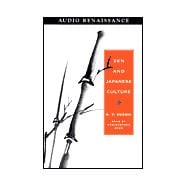From one of the most influential books ever written on Zen's influence on Japan
One of the leading twentieth-century works on Zen by D.T. Suzuki, Zen and the Art of Japanese Culture was originally released on audio as four separate programs--What Is Zen, Zen and the Love of Nature, Zen and the Art of Tea, and Zen and the Samurai. Now, for the first time, they are available in one edition.
After briefly explaining what Zen is, Dr. Suzuki considers in detail various aspects of Japanese art and life that this Buddhist discipline has influenced: the cult of swordsmanship, the tea ceremony, the haiku form of poetry, and the Japanese love of nature. Other essays are devoted to the relationship of Zen and Confucianism, to the role of Zen in the tradition of the Samurai, and to Japanese art.
In simple, often poetic, language enhanced by anecdotes and poetry, D. T. Suzuki describes how Zen evolved, and how its emphasis on primitive simplicity and self-effacement have helped to shape an aesthetic found throughout Japanese culture.
One of the leading twentieth-century works on Zen by D.T. Suzuki, Zen and the Art of Japanese Culture was originally released on audio as four separate programs--What Is Zen, Zen and the Love of Nature, Zen and the Art of Tea, and Zen and the Samurai. Now, for the first time, they are available in one edition.
After briefly explaining what Zen is, Dr. Suzuki considers in detail various aspects of Japanese art and life that this Buddhist discipline has influenced: the cult of swordsmanship, the tea ceremony, the haiku form of poetry, and the Japanese love of nature. Other essays are devoted to the relationship of Zen and Confucianism, to the role of Zen in the tradition of the Samurai, and to Japanese art.
In simple, often poetic, language enhanced by anecdotes and poetry, D. T. Suzuki describes how Zen evolved, and how its emphasis on primitive simplicity and self-effacement have helped to shape an aesthetic found throughout Japanese culture.








